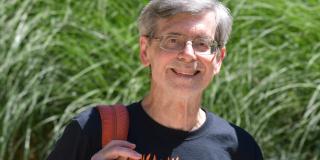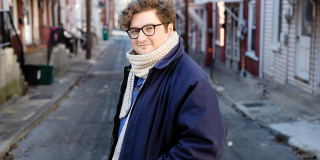
In the early hours of May 13, 1862, Robert Smalls and a crew composed of fellow slaves, stole a cotton steamer in Charleston, SC, picked up family members at a rendezvous point, then navigated their way through the harbor. Once clear of the harbor and outside of Confederate waters, he had his crew surrendered his ship to the blockading Union fleet. Smalls would later go on to serve five terms in the US House of Representatives. His amazing life was depicted in an October world premiere production of Finding Freedom, The Journey of Robert Smalls, at the Gaillard Center in Charleston, with media design by Joseph Amodei.
Combining media with music and stage movement, Amodei, assistant professor of theatre, designed the production’s visual content, blending responsive screen projections with live video and film to connect the audience with the world in which the characters live. Finding Freedom depicts the early years of Smalls enslaved in Beaufort, SC; years learning the land, waters, and Gullah traditions of his mother, the bold seizure of the USS Planter through the Charleston Harbor, and his later life of advocacy in Congress.
“In this case, media design is how content and videos contributed to the story,” Amodei says. “For me, it's blending that with live camera, videos switching work that's mixed, with these more imagistic portraits. And then also I feel like I'm in charge of interactivity, having sound affect the quality of the experience, making sure everything's networked together so it can be really, really precise for some of the movements.”
A world premiere takes months of planning. Amodei says the production team began discussing the broad concepts surrounding the design with director JaMeeka Holloway. Then came weekly conversations, sketching, digital creating, storyboarding, all getting ready for the rehearsal process. Understanding the subject’s context shapes the designs, Amodei adds.
“In a lot of theater processes, designers will often be working on their thing and then come to the tech rehearsal right at the end. With lots of camera work integrated into the show and live media, there's not enough time at the end to really figure all of that out. So, I came in during the second week of a six-week rehearsal process for a week, and set up a rehearsal system with all these cameras to continue testing and iterating just on a TV screen. The director can see everything, the performers can see everything.”
The incorporation of media into productions creates a true interaction, and sense of intimacy, with the audience, Amodei says.
“[Media design] adds a type of liveness that I think people enjoy. We see this type of camera now in concerts, and there's a long history of this type of work, but it's often been hard to do for various reasons or relegated to more experimental work, which is also great. But now, we live such mediated lives, it almost makes sense to bring this type of world into live storytelling.”
After the war, Smalls went on to a successful business career. He purchased his former master’s home, seized earlier by Union tax authorities. In 1868, Smalls was elected to the South Carolina House of Representative and later to the South Carolina Senate. In 1874, Smalls was elected to the U.S. House of Representatives. He died in Beaufort on February 22, 1915.
“Robert Smalls was famous in his time and was known all across the country, and was erased from history during the Jim Crow era on purpose,” Amodei says. “So, getting to share this story in a really contemporary, exciting way and share theater and interactive media performance with an audience is really great. In addition, I get to work with a bunch of artists I love to work with.”
Amodei’s professional work is transitioning quickly to the classroom and to Lehigh productions. The theatre department is staging Rags Parkland Sings the Songs of the Future Nov. 10-17, a musical directed by colleague Lyam Gabel, assistant professor of theatre.
“I'll be doing live camera work in this production,” Amodei says. “There's this underground subterranean element, and I'll be learning how to build this infrastructure. They've done some media design before, but part of what I'm excited to do here is to start showing students the aspects of my work that are on campus. Teaching it to students who want to be involved.”
-by Robert Nichols
Image courtesy of Gaillard Center






